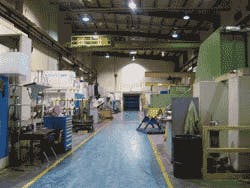Lighting the Way Through Sustainability
Creating an energy management strategy that’s right for your business — and right for your bottom line — can be complicated for any organization. Efficiency is often dictated by a slew of variables and cost components that sometimes change rapidly. With large manufacturers in particular, these factors are regularly compounded by pressures from increasing competition and potential climate change legislation that can make a successful energy management plan all the more difficult to achieve.
Enter Lufkin Industries, a vertically integrated company that specializes in oilfield equipment and power transmission products. Like most manufacturing plants, Lufkin faced similar pressures and energy costs on par with the industry average of 5% to 7% of total operating expenses. Its annual consumption typically reached upward of 70 million kWhr — a number that was expected to rise.
Considering the two standard approaches to managing climbing expenses (cutting costs and increasing sales), Lufkin opted to take a closer look at energy-related expenditures. But the goal wasn’t just to achieve the classic reduction in consumption. Management was looking for more: To develop a plan that addressed all aspects of energy usage, from individual cost components to total environmental impact.
Lufkin teamed with GDF SUEZ Energy Resources, a company headquartered in Houston that is one of the country's largest providers of retail electricity to commercial, industrial, and institutional buyers.
The first step was to conduct an energy audit. In cooperation with American Energy Solutions, GDF SUEZ Energy Resources benchmarked Lufkin’s usage patterns to address potential opportunities to improve enterprise-wide efficiency. The initial assessment provided Lufkin with an opportunity to consider key areas, systems, and manufacturing processes that could be modified to achieve a better return on investment. The final results were astounding.
Of the identified improvement opportunities, one in particular presented the greatest potential not only to save an enormous amount of money, but also to dramatically reduce Lufkin’s carbon footprint and promote its commitment to environmental stewardship. The potential benefits were so significant that the company’s leadership team authorized an unbudgeted capital project to take advantage of the opportunity as quickly as possible.
At the time, nearly a third of the company’s total energy consumption was attributed to lighting. Approximately 30% of its energy was going to a system that consumed far beyond the levels necessary for business operations. That system mainly included high-wattage, metal-halide and high-pressure sodium (HPS) fixtures for hi-bay applications as well as magnetic ballasts and T12 lamps for lo-bay and office lighting.
The proposed plan involved a complete lighting retrofit to convert Lufkin to a much more efficient system with custom fixtures — predominately 4-lamp and 6-lamp T5HO luminaires for hi-bay applications and T8 fixtures with electronic ballasts for lo-bay and office lighting. Occupancy controls were also recommended for installation in select office areas.
The retrofit would take place at five of Lufkin’s facilities, including the corporate office, Buck Creek location, foundry, gear repair facility, and power transmission site. It was estimated that it would reduce the company’s overall energy usage in lighting by 11,938,207 kWh annually, which was nearly 18% of the total electric load. The estimated decrease in kilowatt hours was so substantial that Lufkin qualified for two rebate programs totaling $675,000 as well as federal tax incentives in excess of $100,000 through the Energy Policy Act of 2005.
With the new lighting system, the company would save more than $800,000 per year. Considering the rebates, tax incentives, and resulting annual cash flow from reduced consumption levels, the payback period for the up-front investment of $2 million to fund the initiative would be small – estimated at only about a year and a half. The potential reduction in CO2 emissions was 16,958,929 lb.
Although the retrofit was massive, affecting a wide range of departments and locations, the lighting upgrades were carried out in a phased approach and completed on time and within budget — all without disruption to normal operations.
By going beyond cost-cutting to do the right thing for the company and the environment, Lufkin has found success in sustainability.
